This post has not been edited by the GamesBeat staff. Opinions by GamesBeat community writers do not necessarily reflect those of the staff.
Before I get this started, I just want to say thank you to all of my readers on Bitmob, Screwattack and Blistered Thumbs for making 2010 a fantastic year. On the Bitmob end I would like to thank Omar and all of the other Spotlight writers who gave my work some very good exposure and feedback. From Screwattack I would like to thank Destin for giving me the chance to be a news writer. Luis AKA Bigboss117 for being so awesome and for covering the other half of the blogging blitz that was E3. I would also like to thank Xona Games for giving me a great interview (check out their work on Xbox Live Indie Games, it’s fantastic). I should also thank Modewondershot, Yorski and LinksOrcarina for offering their support and constructive criticism on the Blistered Thumbs forums. I would also like to thank Ethan Einhorn and Chris Sharpley for putting me on this path to begin with, as well as my journalism instructors at Holland College and The Yarmouth Vangard for making so many great journalism experiences possible. Of course I would also like to thank all of you for reading ?.
Now that 2010 has come and gone, many websites, bloggers and magazines (the few that still exist) have all weighed in on their game of the year contenders, so I figured that I would give into peer pressure (although I’m not technically a part of the gaming press yet) and review my choice for game of the year.
I must say that my choice is a bit on the unusual side and many of you are going to be wondering why I haven’t gone with the standard choices like Mass Effect 2, Red Dead Redemption or Mario Galaxy 2. I can tell you with 100 percent honesty that I haven’t played any of those games and even if I did, I probably wouldn’t give them my top spot anyway, since I prefer to give it to a great game that tends to be overlooked.
Although I should say that games like Super Meat Boy, Limbo, Scott Pilgrim, Super Street Fighter IV, Mega Man 10, Decimation X3 and a few others that I haven’t reviewed yet were close to taking this spot.
Anyway, without any further adieu, I present to you my choice for game of the year:
Professor Layton & The Unwound Future!
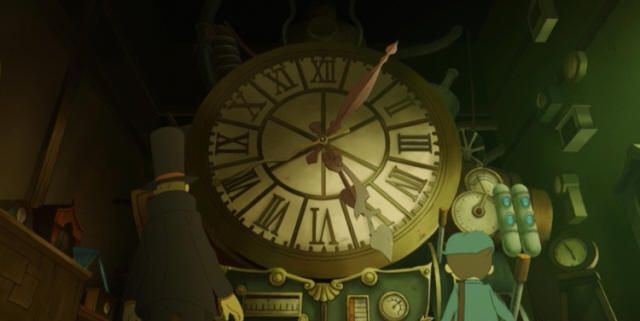
OK, so I know that some of you may have seen this coming, since I have made my love for this series crystal clear on numerous occasions but with an art and musical style this unique and characters that are this charming in a story this fantastic, it can’t help myself from latching on to each entry in the series. And I must say that Unwound Future is the best by far. I know that ranking a family friendly puzzle point and click adventure as game of the year might damage my credibility but I ask that you hear me out.
I will begin with what is usually the main selling point for me when it comes to a game in the Professor Layton series and that is the game’s plot. The story begins with Professor Layton and his young apprentice (I think he’s 12 but I’m not 100 per cent on that) Luke Triton as they are discussing a rather strange letter that has been sent to the Professor. Apparently it has been sent from 10 years into the future. Who sent the letter? Well, it was actually Luke’s future self.
In the letter, Future Luke says that the London of his time has been thrown into a state of absolute chaos and he needs his former mentor’s help to make things right. At first Layton shrugged off the letter’s claim and figured it was just Luke having a bit of fun with him but he begins to take the note more seriously after recalling a demonstration of an actual time machine the week before. The demonstration went array and resulted in the disappearance of England’s Prime Minister as well as some of the country’s top scientists. So, the Professor and his apprentice begin to investigate the strange goings on by following the instructions in the letter, when doing so, the pair find themselves in Future London, which is by no means a happy place. The city is a bleak and dilapidated shadow of its former glory with a criminal syndicate simply known as The Family running things. It is up to the Professor to save from Future London from the clutches of The Family, as well as to discover their link to the time machine and to stop them from using it for evil.
The game’s story is incredibly strong. The character reactions to the time travel elements provide a good bit of fun and all but the real strength of the plot comes from the flashbacks from the Professor’s past, Luke’s small sub plot, the true reason for the creation of the time machine, the connection between these events and the time machine demonstration and the motivations behind the villain’s master plan.
Personally I feel that the game is actually fairly dark for a family friendly title but animation great Don Bluth (pre-Rock a Doodle anyway) had a principle that you could put as many scary and depressing moments into a children’s feature as you could, as long as you provided the audience with a happy ending. Hell, even some of the minor characters have depressing back-stories. That principle may be used in the context of film but it works here. Everything melds together at the end to make for one of the more emotionally engaging climaxes I have played through and I will admit that I came close to tearing up at the end. The player is given a nice heart-warming ending but he/she should be prepared to have it broken a few times before reaching that point.
I also want to point out one more thing about the plot. It was nice to have a villain who was actually intimidating for a change. I like Don Paolo and all but he’s been more of a bumbling comedic foil.
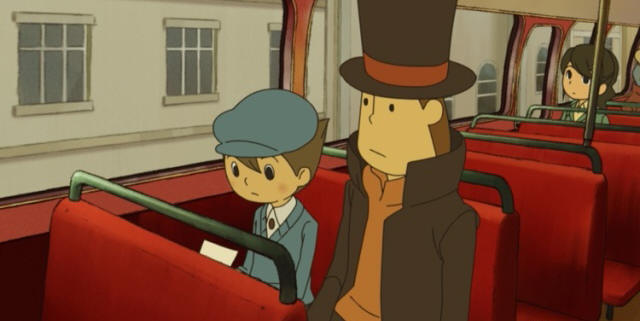
(Luke and The Professor evaluating the situation. Could this letter really be from the Future?)
I could go on the usual spiel about how much I love the game’s art style and how it and the character designs reminds me of European animations like The Triplets of Belleville or anime titles created by Osamu Tezuka and Hayao Miyazaki. But since I brought that up in my reviews of the first two games, I will instead talk about how the look of the series has improved, as well as the appearance of Future London.
The animated cutscenes are a little more refined than they were in the previous installments. The picture quality is fantastic and I’d almost swear that I was watching a DVD. Definitely the best quality animation I have seen on the DS thus far. I will also say that I was glad that Level-5 decided to add more cutscenes, this time around, which take up roughly about 30 minutes of game time.
Speaking of animation, the in game character animations have also been improved. These animations are still limited in the sense that for the most part they are standing in place but all of the characters (even the minor ones) show signs of movement and even change facial expressions. There are even some instances where these still images are given the illusion of forward motion. For example there is this cute little scene where Luke is running and bumps into another character, this is shown by quickly moving the images across the screen, to give the impression that they were animated. I thought this was a really clever way of getting around the limited use of animation during the in game dialogue scenes.
As far as the look of Future London goes, I really must say that this is one of the more realistic representations of the possible future scenario I have ever seen. There are no flying cars or robots or any real sense of scientific advancement (well other than the time machine). But there are some more realistic changes in terms of environment and urban development. Streets have changed, there is a new subway system that has replaced the transit system and new buildings are being constructed, while others seem to be in a state of disrepair or are missing all together. There is also a new district that has been added to the city. It should also bee noted that with The Family constantly patrolling the city, the streets are much less busy than they were in the past and those who are roaming around are understandably not happy with what is going on. But they still manage to keep a positive attitude and make the best of it. This serves as a great contrast to the Present London, which is safer, brighter and full of life.
Well, it looks that despite my best efforts, I am going to have to repeat myself because it bares repeating. Tomohito Nishiura is a fantastic composer and he continues his hot streak of memorable tracks with Unwound Future’s score. His use of European style folk music continues to impress and perfectly meld with Layton’s world. The music tends to be gloomier than the previous installments, considering the atmosphere and the particularly heavy plot developments that happen later on. The tracks range from melancholy to down right urgent. No matter the situation, Nishiura’s music will be there to elevate the already strong plot twists. Although it should be said that are a few cheery songs added into the mix as well, like the variations of the mini-game theme and the cool, jazz inspired Casino theme.
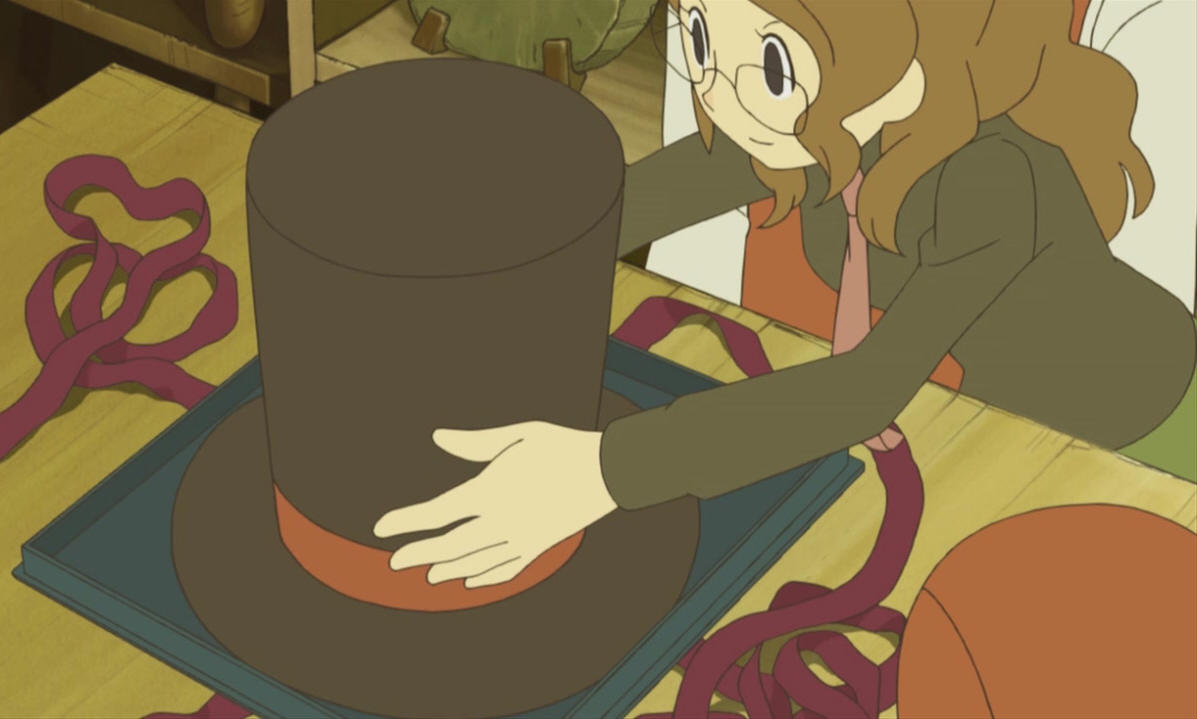
(The secret origns of Layton's signature top hat revealed and it will make you sad)
Speaking of audio presentation, I should also say the voice actors do another solid job here and get even more time to shine during the cutscenes and some of the key in game dialogue scenes. Like always, it would have been nice to hear the voices more often (or even during every conversation) but it seems that we get the hear the voice work a little bit more with each title in series, so I’m happy with that bit of progress.
Gameplay wise, Unwound Future is pretty much the same as the other entries in the series. It is a point and click style adventure where the player will have to click on items and talk to other characters as you gather clues and information about the situation of Future London. But to figure out what these clues mean or to get characters to talk, you will have to solve a puzzle. Each puzzle is worth a certain amount of Picorats that can be used to unlock bonus content at the end of the game. Entering wrong answers reduces the amount of Picorats won but you can use The Memo feature (first introduced in Diabolical Box) to help draw possible solutions on the touch screen and Hint Coins (you can use three per puzzle), which provide clues to help with those particularly tough head scratches. You know the drill.
Or do you?
A great new feature has been added to series, which really helps with those really hard puzzles. This feature is known as the Super Hint Coin. Super Hint Coins work in the exact same way as regular Hint Coins, except they pretty much layout most of the solution for you, leaving you with the simple task of connecting the rest of the dots. But it comes with a cost. Super Hints require you to use up the three regular coins and they also use up two coins, so make sure to use them wisely. The Super Hint helps to keep things running more smoothly, since you don’t have to spend hours thinking up solutions to a particular puzzle if you don’t want to.
Another new aspect of the game that I happen to find interesting is the fact that Layton and Luke aren’t the only two puzzle solvers in the group. Future Luke and even Flora lend a hand as well. It’s a nice little addition that keeps things from getting too repetitive.
As for the puzzles, some of them are the same type of brainteasers and word problems as seen in the previous games but there is also a good variety of uniquely different puzzles scattered among the batch. There are puzzles that require you to use Tetris blocks to fill in a picture. Some will have you guide the Professor through streets that are littered with slippery banana peels. Others include a nice twist on the typical maze puzzle, or have you perform the seemingly simple task of making a sandwich and for the first time since Curious Village, there is a match stick puzzle.
It should also be said that there even more puzzles that revolve around the story this time around, like helping someone escape The Family by counting the number of goons in the picture or solving a few trap puzzles to reach your new enemy and of course there is the now infamous Slot Machine Gun puzzle. There is also an entirely new concept that has been thrown in, which works out quite well. These are Puzzle Battle’s which pit the Professor against an opponent in a battle of wits. This only happens twice but it is a nice and challenging little addition that keeps things fresh.
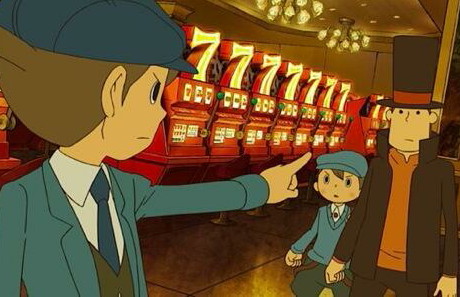
(Will this puzzle battle prove that the student has become the master?)
And of course, you can’t talk about Unwound Future’s gameplay elements without talking about the mini-games. The Layton series is known for having a selection of mini-games (usually three) that Luke and Layton come across throughout each game. In most instances, these mini-games are a fun little distraction that can give a slight extension to the play through, as well as help to unlock some of the most difficult puzzles in the game. In Unwound Future, the mini-games make a return but unfortunately two of them don’t really match up with the fun factor of those featured in the previous installments.
The first mini-game is a collection of three storybooks that must be filled with stickers that are given to you after solving certain puzzles. It is up to you to chose the correct stickers to fill in the blanks to complete each of the three stories. It’s cute and it could provide some nice reading material for younger children but it can be rather bland for older players. At least it provides some nice little references to Curious Village.
The second mini-game is the parrot mini-game. I really hate this one. Basically, you are using a parrot to deliver packages to other characters. To do this you must help guide the parrot from one side of the screen to the next. To do this, you draw three or four bits of rope on the touch screen that will connect one pillar to another. The parrot will bounce (I missed the memo saying that parrots are now flightless) from one rope to another. This seems like a good idea for a game but the parrot has a habit of bouncing in the wrong direction, or bouncing off the screen, or even bouncing into the little walls that block his path. It’s frustrating and I admit I was only able to make half of these deliveries.
The last mini-game is probably the best one in the entire series. The Toy Car mini-game has you building tracks for Luke’s toy car, with the objective being to collect all of the items on screen, then reach the goal and to it without hitting any obstacles or falling off of the track. This is challenging but it is also a lot of fun and I actually found myself taking time away from playing the main game to figure out the solutions for certain tracks.
And lastly, you have the typical bonus content that keeps dedicated players coming back for more. These features are the character profiles, the game’s soundtrack, voice samples, the cutscene and in game art galleries and of course Layton’s Challenges (the hardest puzzles in the game). There are also weekly puzzles that can be downloaded using the DS Wi-Fi and a Diabolical Box themed puzzle that be unlocked using a code found in Diabolical Box’s manual. You can also solve all of the previous puzzles as many times as you want, if you wish to do so.
I will admit that since it might not be ideal to play though the entire game multiple times or not at least until you forget all of the puzzle solutions. But the game does have a good initial shelf life of 12-20 hours and the bonus content is likely to bring players back for more, especially (well in my case anyway) the cutscenes and soundtrack.
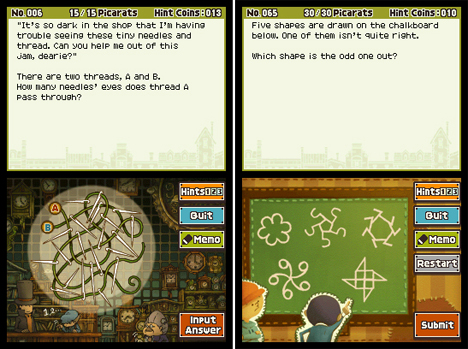
(Just a small sample of the brain testing puzzles that await for you in The Unwound Future)
Professor Layton & The Unwound Future is perfect title for those who are fans of puzzle games, as well as those who like well written stories. The prequel trilogy has some big shoes to fill. I hope they don’t pull a Star Wars. ;)
Final Score: 9/10
Like I have already said, I know that some of you are not going to like the score but I absolutely loved playing this game and I can honestly say that there was a week long period where I did not want to put it down. Not mention, when writing this review I had a hard time finding the minor things to gripe on about. Besides, I consider the gameplay mechanics to be perfect for a puzzle game like this and I found the story and soundtrack to be considerably moving and it has been quite sometime since a story in a game has been able to do that. So, if you disagree with the score that’s fine. We all have our own tastes. I just wanted to share mine with you.
Let’s all hope for great things in gaming and in life in 2011. Thank you all again for reading and Happy New Year!
